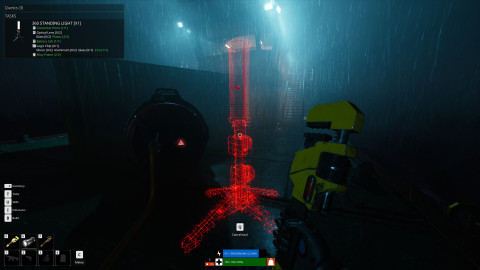
Update direction announced, changes projected to the real estate system
In the current real estate system, relatively few investors make a meaningful return on their daily rewards. Many are running deficits that cost more in repairs than they make in daily revenue, and many are devaluing themselves by breaking up large parcels of land into the smallest 1x1s. The current real estate system suffers from the following problems.
|
The problems of the current real estate system - Excessive repair costs - Unfavorable investment bonus to high-value large buildings - Poor correlation between real estate compensation and market value - Remnants of market disruptive behavior |
On May 17, an update was announced to address this issue. It goes beyond simply reducing the burden of repair costs and includes changes to the way investment scoring is calculated, which is the basis for daily real estate rewards. It also fixes the economic structure that had previously favored tearing down large buildings to break up land and build smaller buildings.
|
Announced real estate content improvements - Changing building repair commodity from crystals to gold - Changing investment bonus criteria from building quantity to land cell quantity - New building size bonus - Removing land value from investment scoring criteria - Separating property score and property price - Strengthening building rating bonuses - Reducing the cost of building upgrades Changed calculation formula for investment points - Current: {Land value + (Construction bonus x grade bonus x land bonus x durability depreciation)} x building quantity investment bonus - Suggested formula: (Construction bonus x grade bonus x building size bonus x land bonus) x land cell quantity investment bonus |
Farewell to house poors? Building repair commodity changed to gold
The current real estate reward system determines your investment score based on the value of your land and buildings, and as of May 19, you receive about 30 crystals for every 100,000 investment points. However, a building with an appraised value of 100,000 points costs between 33 (★6 and above) and 50 (★3 and below) crystals per day to repair, depending on its rating. So if you can't inflate your investment score with an investment bonus based on the number of buildings, it's better not to repair them.
To improve this burden, the building repair commodity will change from crystals to gold. It is not yet known what the actual repair costs will be, but if you're an investor who uses both board games and real estate, this will significantly reduce your maintenance costs. What's more, the May 17 reveal leaves out depreciation due to building durability. In fact, if depreciation is removed, building repair intervals will increase, which will also increase convenience.


The end of dividing into 1x1s, investment bonus changed & size bonus added
Whether it is beneficial to repair buildings depends on how much investment bonus you receive. The investment bonus depends on the number of buildings you have, with the maximum being x2 if you have 10 or more buildings to maximize your return. This is why there are more investors on large plots of land demolishing existing buildings and breaking them down to the smallest size, 1x1, to increase the number of buildings.
This has led to a disconnect between the value of a property and its profitability. For example, it is more profitable to tear down a 4x3 building and break it up into 12 1x1 buildings than to have only one 4x3 building. Obviously, the value of the property is higher for the one 4x3, but the profitability is higher for the 12 1x1s.
To address this, the investment bonus calculation changed from the number of buildings you have to the number of land cells you have. You will receive the same investment bonus even if you don't split your buildings. In addition, there will be a new bonus based on building size, so that a large building will have a much higher investment score than multiple smaller ones. Now, splitting a large land cell is just a waste of money, and it's more important to buy up neighboring land to build bigger buildings.

Erase the aftermath of market disruptions! Decoupling market price from real estate reward
The current real estate investment score calculation also includes the value of the land. The value of the land is determined by the average transaction price of the surrounding land, which means that the daily real estate reward is partially tied to the market value of the property. The problem is that the market has been disrupted by bad accounts, and the low profitability of the daily reward has made the correlation between investment score and market value very low. Especially in places where there has been a lot of splitting and low-price sales, the market value per 1x1 size land is less than 2,000 crystals.
The solution to this is quite a radical remedy. By removing the value of land from the real estate investment scoring criteria, the link between market price and real estate rewards is also removed. Properties that have seen their market value plummet because neighboring properties were sold at abnormally low prices by bad users will now be able to earn their daily real estate rewards. Conversely, properties that have seen their market value inflated by insider trading will also see their real estate rewards normalized.
Ironically, the decoupling of market prices from property rewards will make the two more relevant: once the volatility of the investment score, which determines a property's daily reward based on market influences, is removed, investors will be able to see the value of a property through the objective lens of the investment score. In addition, there will be price adjustments to normalize disturbed markets.

Will there be more ★7 buildings? Reduced upgrade cost and grade bonus increased
Currently, a building's investment score is calculated as 'building construction bonus × building grade bonus × land bonus × building durability depreciation'. Upgrading a building to increase its grade increases the grade bonus, which increases the building's appraised value, and the grade increases its maximum durability, which reduces building repair costs and depreciation.
However, the high cost of upgrading, the low chance of success, and the fear of a rating drop at ★5 and above discourage people from attempting to upgrade. Although the cost of upgrading adds to your construction bonus, you don't get this effect if your construction bonus is already capped.
That's why Marblex decided to not only increase the grade bonuses of buildings, but also lower the cost of upgrading them at the same time. This will increase the impact of upgrading buildings on daily real estate rewards, while making it easier for investors to attempt upgrades. The construction bonuses will also increase slowly, so even ★5 and above buildings will get a lot of utility from a single upgrade attempt.

Real estate paradigm shifts, prepare with rebate event
The direction of the real estate system update, announced on May 17, points investors toward "holding larger, higher-rated buildings." It will also remove the influence of real estate prices and market disturbances, allowing for more objective value judgments in real estate transactions.
This direction will require new buildings to be constructed on previously fragmented land parcels. For investors who want to reorganize their real estate portfolios in line with the new direction, Marblex will reimburse the cost of building a property. The reimbursement will be for the construction cost of the new building after demolishing the old one, and will run from May 17 until the next update. For example, if you demolish a building that was built on six 1x1 plots of land and merge them to create a 2x3 plot of land to build a new building, the construction cost of the 2x3 building is eligible for reimbursement. However, if the building is not demolished and placed in storage, or if the property has a history of transactions, it is not eligible for reimbursement, nor is the cost of upgrades.

Sort by:
Comments :0







